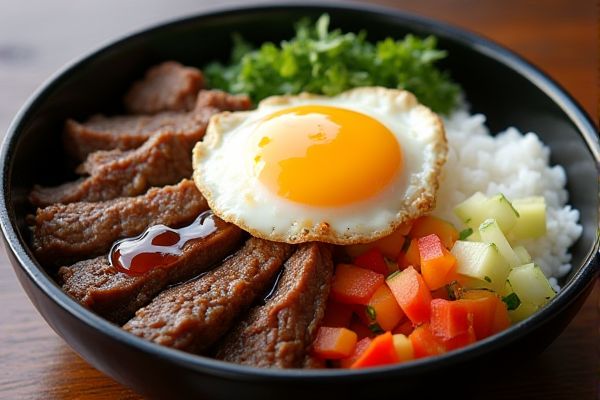
Beef Sukiyaki Bibimbap from Gyu-Kaku features tender marinated beef, sauteed vegetables, and a sunny-side-up egg served over steamed rice, all topped with flavorful sukiyaki sauce for a savory and satisfying Korean-Japanese fusion dish.
Equipments
- Rice cooker
- Frying pan or skillet
- Saucepan
- Mixing bowls
- Chef’s knife
- Cutting board
- Tongs
- Spatula
- Measuring cups and spoons
- Plate or serving bowls
Ingredients
- 1 lb (450g) thinly sliced beef ribeye
- 2 cups steamed white rice
- 2 tablespoons vegetable oil
- 1 small onion
- 1 cup shiitake mushrooms
- 1 cup spinach
- 1 cup bean sprouts
- 1 small carrot
- 2 green onions
- 2 tablespoons soy sauce
- 2 tablespoons mirin
- 2 tablespoons sake
- 1 tablespoon sugar
- 1/4 cup sukiyaki sauce
- 4 large eggs
- Toasted sesame seeds
- Kimchi (optional)
Thinly sliced beef ribeye is essential for the tender texture characteristic of Beef Sukiyaki Bibimbap, so be sure to choose high-quality cuts. Fresh vegetables like spinach, shiitake mushrooms, and bean sprouts should be crisp and vibrant to maintain their natural flavors during sauteing. Sukiyaki sauce combines soy sauce, mirin, sake, and sugar to create the signature savory glaze, making it important to balance these ingredients precisely. Steamed white rice must be fluffy and warm to complement the rich beef and vegetables perfectly. You can recreate the authentic taste of Beef Sukiyaki Bibimbap from Gyu-Kaku with these key ingredients and techniques.
Instructions
- Cook white rice in rice cooker.
- Slice onion, shiitake mushrooms, carrot, and green onions.
- Prepare spinach and bean sprouts by washing and trimming as needed.
- Mix soy sauce, mirin, sake, and sugar in a bowl for homemade sauce (if not using sukiyaki sauce).
- Heat vegetable oil in frying pan over medium-high heat.
- Sauté onions, then add mushrooms, carrots, spinach, and bean sprouts until tender (cook separately if preferred).
- Remove vegetables and set aside.
- In the same pan, add more oil if needed and cook sliced beef until browned.
- Pour sukiyaki sauce over beef and simmer briefly.
- Fry eggs sunny-side up in a separate pan.
- Assemble: Place steamed rice in serving bowls.
- Arrange sautéed vegetables and beef evenly over the rice.
- Top each bowl with a sunny-side-up egg.
- Drizzle extra sukiyaki sauce as desired.
- Garnish with sliced green onions and toasted sesame seeds.
- Serve with kimchi (optional).
Substitution
Beef Sukiyaki Bibimbap from Gyu-Kaku can be easily adapted if you don't have all the exact ingredients on hand. Thinly sliced ribeye may be substituted with thinly sliced sirloin or flank steak to maintain tenderness and flavor. If sukiyaki sauce is unavailable, combine soy sauce, mirin, sake, and sugar to create a similar sweet and savory glaze. Spinach and bean sprouts can be swapped with other greens like kale or bok choy depending on your preference. Your final dish will remain satisfying even with these simple ingredient swaps, ensuring delicious results every time.
Tips
Make sure to cook each vegetable separately to maintain their individual textures and flavors in your Beef Sukiyaki Bibimbap. When frying the beef, use a hot pan and avoid overcrowding to achieve a proper sear and prevent steaming. Use freshly steamed rice that is warm to help blend the flavors and provide the best texture under the cooked toppings. For the perfect sunny-side-up egg, cook gently over low heat until whites are set but yolks remain runny to enhance your dish's richness.
Nutritions
Beef Sukiyaki Bibimbap provides a balanced mix of macronutrients with protein-rich ribeye beef and eggs, complemented by fiber-rich sauteed vegetables like spinach, carrots, and mushrooms. The steamed white rice supplies a substantial source of carbohydrates to fuel your energy levels, while the sukiyaki sauce adds flavor with minimal calories. This dish contains vitamins A and C from the vegetables and essential amino acids from the beef and eggs, supporting muscle repair and immune function. Your meal is also enriched with antioxidants and minerals such as iron and potassium, important for overall health and vitality.
Storage
Store leftover Beef Sukiyaki Bibimbap in an airtight container within the refrigerator to maintain freshness, ideally consuming it within 2-3 days. Separate the sunny-side-up egg if possible to prevent sogginess and reheat the beef and vegetables gently in a skillet to preserve texture. Your rice cooker can be used to reheat rice evenly by adding a small amount of water before warming.
Variation or Alternatives
You can substitute thinly sliced chicken or tofu for the beef to cater to different dietary preferences while maintaining protein richness. Try stir-frying vegetables separately with a splash of sesame oil to enhance their aroma and flavor. Instead of a sunny-side-up egg, a soft boiled or poached egg can add a creamy texture and blend well with the sukiyaki sauce. Toasted seaweed strips can be added as a garnish to bring an extra layer of umami to your Beef Sukiyaki Bibimbap.
Allergies
Beef Sukiyaki Bibimbap contains common allergens such as soy from soy sauce and sukiyaki sauce, and eggs used as a sunny-side-up topping. Sesame seeds, often included as a garnish, can also trigger allergic reactions for some individuals. You should exercise caution if you have allergies to soy, eggs, or sesame when enjoying this Korean-Japanese fusion dish.
Why this recipe?
Beef Sukiyaki Bibimbap from Gyu-Kaku offers a flavorful combination of tender, marinated beef cooked in a savory sukiyaki sauce and perfectly mixed with warm rice and fresh vegetables. The dish is celebrated for its balance of sweet, salty, and umami flavors, creating a satisfying and hearty meal. Your taste buds will experience the rich, authentic Japanese barbecue essence that makes it a standout choice. Trying to make a copycat version allows you to recreate this delicious harmony at home, customizing ingredients to suit your preferences while enjoying a restaurant-quality dish.
